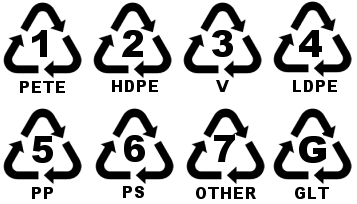
Questions, comments, or just want to get involved in the discussion? Head on over to the discussion forum!

|
|
|

Recycling by the numbers
Recycling plastics - what the numbers mean
On most plastic jars, containers and other packaging of products you buy, you'll find what's generally accepted as the recycling logo with a number in the middle and letters underneath stamped into the plastic.
The recycling logo can be a little misleading - just about anything can be recycled, but sometimes not without major effort. It's a little bit like extracting oil from under the ocean bed compared to extracting oil from tar sands; none of it's really good as such, but some plastics are far, far worse than others.
The Society of the Plastics Industry (SPI) implemented the system in 1988 to allow recyclers to be able to tell the different types of plastics when sorting. Basically, the numbers in the triangle indicate the grade of plastic - the resin ID code. It's now a system that's used in many different countries.

Here's what to look for and what it all means:
1 - PETE - Polyethylene Terephthalate
The easiest of plastics to recycle. Often used for soda bottles, water bottles and many common food packages. Is recycled into bottles and polyester fibers
2 - HDPE - High density Polyethylene
Also readily recyclable - Mostly used for packaging detergents, bleach, milk containers, hair care products and motor oil. Is recycled into more bottles or bags.
3 - PVC - Polyvinyl Chloride
This stuff is everywhere - pipes, toys, furniture, packaging - you name it. Difficult to recycle and PVC is a major environmental and health threat.
4 - LDPE Low-density Polyethylene
Used for many different kinds of wrapping, grocery bags and sandwich bags and can be recycled into more of the same.
5 - PP - Polypropylene
Clothing, bottles, tubs. Can be recycled into fibers.
6 - PS - Polystyrene
Cups, foam food trays, packing peanuts. Polysterene is a real problem as it's bulky yet very lightweight and isn't really worth recycling.
7 - Other
Could be a mixture of any and all of the above. Avoid it if you can - recyclers don't want it.
G - GLT - Green Living Tips
The Green Living Tips logo of course! - sorry, couldn't resist :)
So there you have it - the recycling logo when stamped into plastic isn't a guarantee that what it's stamped into is easily recyclable and in some cases it's not at all. Look for products where the packaging is stamped 1 or 2 where you can.
Michael Bloch
Green Living Tips.com
Green Living Tips is an online resource powered by renewable energy offering a wide variety of earth friendly tips, green guides, advice and environment related news to help consumers and business reduce costs, consumption and environmental impact on the planet. |
|